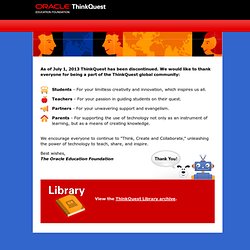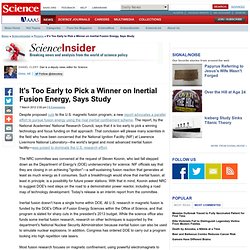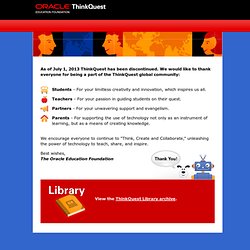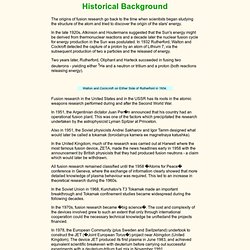

Untitled. As of July 1, 2013 ThinkQuest has been discontinued.

We would like to thank everyone for being a part of the ThinkQuest global community: Students - For your limitless creativity and innovation, which inspires us all. Teachers - For your passion in guiding students on their quest. Partners - For your unwavering support and evangelism. Parents - For supporting the use of technology not only as an instrument of learning, but as a means of creating knowledge. We encourage everyone to continue to “Think, Create and Collaborate,” unleashing the power of technology to teach, share, and inspire. Best wishes, The Oracle Education Foundation. It's Too Early to Pick a Winner on Inertial Fusion Energy, Says Study. Despite proposed cuts to the U.S. magnetic fusion program, a new report advocates a parallel effort to pursue fusion energy using the rival inertial confinement scheme.

The report, by the National Academies' National Research Council, says that it is too early to pick a winning technology and focus funding on that approach. That conclusion will please many scientists in the field who have been concerned that the National Ignition Facility (NIF) at Lawrence Livermore National Laboratory—the world's largest and most advanced inertial fusion facility—was poised to dominate the U.S. research effort. The NRC committee was convened at the request of Steven Koonin, who last fall stepped down as the Department of Energy's (DOE) undersecretary for science. NIF officials say that they are closing in on achieving "ignition"—a self-sustaining fusion reaction that generates at least as much energy as it consumes. Inertial fusion doesn't have a single home within DOE. ITER - the way to new energy.
Fusion: Magnetic Confinement. As of July 1, 2013 ThinkQuest has been discontinued.

We would like to thank everyone for being a part of the ThinkQuest global community: Students - For your limitless creativity and innovation, which inspires us all. Teachers - For your passion in guiding students on their quest. Partners - For your unwavering support and evangelism. Parents - For supporting the use of technology not only as an instrument of learning, but as a means of creating knowledge. We encourage everyone to continue to “Think, Create and Collaborate,” unleashing the power of technology to teach, share, and inspire. Best wishes, The Oracle Education Foundation.
Nuclear Fusion. How Nuclear Fusion Reactors Work" Current nuclear reactors use nuclear fission to generate power.

In nuclear fission, you get energy from splitting one atom into two atoms. In a conventional nuclear reactor, high-energy neutrons split heavy atoms of uranium, yielding large amounts of energy, radiation and radioactive wastes that last for long periods of time (see How Nuclear Power Works). In nuclear fusion, you get energy when two atoms join together to form one. In a fusion reactor, hydrogen atoms come together to form helium atoms, neutrons and vast amounts of energy. It's the same type of reaction that powers hydrogen bombs and the sun. There are several types of fusion reactions. Proton-proton chain - This sequence is the predominant fusion reaction scheme used by stars such as the sun. Conceptually, harnessing nuclear fusion in a reactor is a no-brainer. Timeline of nuclear fusion. Historical Background. The origins of fusion research go back to the time when scientists began studying the structure of the atom and tried to discover the origin of the stars' energy.

In the late 1920s, Atkinson and Houtermans suggested that the Sun's energy might be derived from thermonuclear reactions and a decade later the nuclear fusion cycle for energy production in the Sun was postulated. In 1932 Rutherford, Walton and Cockroft detected the capture of a proton by an atom of Lithium 7, via the subsequent production of two a particles and the released of energy.
Two years later, Rutherford, Oliphant and Harteck succeeded in fusing two deuterons - yielding either 3He and a neutron or tritium and a proton (both reactions releasing energy). Fusion research in the United States and in the USSR has its roots in the atomic weapons research performed during and after the Second World War. In 1951, the Argentinian dictator Juan Pern announced that his country had an operational fusion plant.